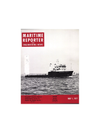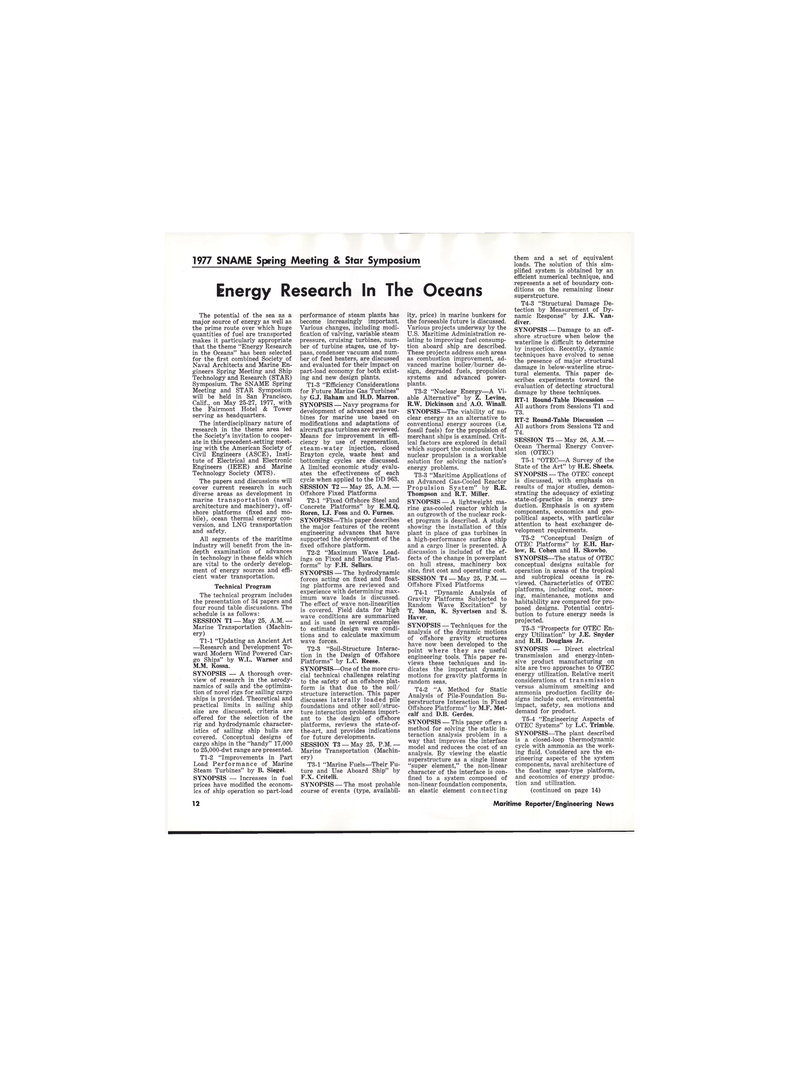
Page 10: of Maritime Reporter Magazine (May 1977)
Read this page in Pdf, Flash or Html5 edition of May 1977 Maritime Reporter Magazine
1977 SNAME Spring Meeting & Star Symposium
Energy Research In The Oceans
The potential of the sea as a major source of energy as well as the prime route over which huge quantities of fuel are transported makes it particularly appropriate that the theme "Energy Research in the Oceans" has been selected for the first combined Society of
Naval Architects and Marine En- gineers Spring Meeting and Ship
Technology and Research (STAR)
Symposium. The SNAME Spring
Meeting and STAR Symposium will be held in San Francisco,
Calif., on May 25-27, 1977, with the Fairmont Hotel & Tower serving as headquarters.
The interdisciplinary nature of research in the theme area led the Society's invitation to cooper- ate in this precedent-setting meet- ing with the American Society of
Civil Engineers (ASCE), Insti- tute of Electrical and Electronic
Engineers (IEEE) and Marine
Technology Society (MTS).
The papers and discussions will cover current research in such diverse areas as development in marine transportation (naval architecture and machinery), off- shore platforms (fixed and mo- bile), ocean thermal energy con- version, and LNG transportation and safety.
All segments of the maritime industry will benefit from the in- depth examination of advances in technology in these fields which are vital to the orderly develop- ment of energy sources and effi- cient water transportation.
Technical Program
The technical program includes the presentation of 34 papers and four round table discussions. The schedule is as follows:
SESSION T1 — May 25, A.M. —
Marine Transportation (Machin- ery)
Tl-1 "Updating an Ancient Art —Research and Development To- ward Modern Wind Powered Car- go Ships" by W.L. Warner and
M.M. Kossa.
SYNOPSIS — A thorough over- view of research in the aerody- namics of sails and the optimiza- tion of novel rigs for sailing cargo ships is provided. Theoretical and practical limits in sailing ship size are discussed, criteria are offered for the selection of the rig and hydrodynamic character- istics of sailing ship hulls are covered. Conceptual designs of cargo ships in the "handy" 17,000 to 25,000-dwt range are presented.
Tl-2 "Improvements in Part
Load Performance of Marine
Steam Turbines" by B. Siegel.
SYNOPSIS — Increases in fuel prices have modified the econom- ics of ship operation so part-load performance of steam plants has become increasingly important.
Various changes, including modi- fication of valving, variable steam pressure, cruising turbines, num- ber of turbine stages, use of by- pass, condenser vacuum and num- ber of feed heaters, are discussed and evaluated for their impact on part-load economy for both exist- ing and new design plants.
Tl-3 "Efficiency Considerations for Future Marine Gas Turbines" by G.J. Baham and H.D. Marron.
SYNOPSIS — Navy programs for development of advanced gas tur- bines for marine use based on modifications and adaptations of aircraft gas turbines are reviewed.
Means for improvement in effi- ciency by use of regeneration, steam-water injection, closed
Brayton cycle, waste heat and bottoming cycles are discussed.
A limited economic study evalu- ates the effectiveness of each cycle when applied to the DD 963.
SESSION T2 — May 25, A.M. —
Offshore Fixed Platforms
T2-1 "Fixed Offshore Steel and
Concrete Platforms" by E.M.Q.
Roren, I.J. Foss and O. Furnes.
SYNOPSIS—This paper describes the major features of the recent engineering advances that have supported the development of the fixed offshore platform.
T2-2 "Maximum Wave Load- ings on Fixed and Floating Plat- forms" by F.H. Sellars.
SYNOPSIS — The hydrodynamic forces acting on fixed and float- ing platforms are reviewed and experience with determining max- imum wave loads is discussed.
The effect of wave non-linearities is covered. Field data for high wave conditions are summarized and is used in several examples to estimate design wave condi- tions and to calculate maximum wave forces.
T2-3 "Soil-Structure Interac- tion in the Design of Offshore
Platforms" by L.C. Reese.
SYNOPSIS—One of the more cru- cial technical challenges relating to the safety of an offshore plat- form is that due to the soil/ structure interaction. This paper discusses laterally loaded pile foundations and other soil/struc- ture interaction problems import- ant to the design of offshore platforms, reviews the state-of- the-art, and provides indications for future developments.
SESSION T3 — May 25, P.M. —
Marine Transportation (Machin- ery)
T3-1 "Marine Fuels—Their Fu- ture and Use Aboard Ship" by
F.X. Critelli.
SYNOPSIS — The most probable course of events (type, availabil- ity, price) in marine bunkers for the forseeable future is discussed.
Various projects underway by the
U.S. Maritime Administration re- lating to improving fuel consump- tion aboard ship are described.
These projects address such areas as combustion improvement, ad- vanced marine boiler/burner de- sign, degraded fuels, propulsion systems and advanced power- plants.
T3-2 "Nuclear Energy—A Vi- able Alternative" by Z. Levine,
R.W. Dickinson and A.O. Winall.
SYNOPSIS—The viability of nu- clear energy as an alternative to conventional energy sources (i.e. fossil fuels) for the propulsion of merchant ships is examined. Crit- ical factors are explored in detail which support the conclusion that nuclear propulsion is a workable solution for solving the nation's energy problems.
T3-3 "Maritime Applications of an Advanced Gas-Cooled Reactor
Propulsion System" by R.E.
Thompson and R.T. Miller.
SYNOPSIS —A lightweight ma- rine gas-cooled reactor which is an outgrowth of the nuclear rock- et program is described. A study showing the installation of this plant in place of gas turbines in a high-performance surface ship and a cargo liner is presented. A discussion is included of the ef- fects of the change in powerplant on hull stress, machinery box size, first cost and operating cost.
SESSION T4 —May 25, P.M.—
Offshore Fixed Platforms
T4-1 "Dynamic Analysis of
Gravity Platforms Subjected to
Random Wave Excitation" by
T. Moan, K. Syvertsen and S.
Haver.
SYNOPSIS — Techniques for the analysis of the dynamic motions of offshore gravity structures have now been developed to the point where they are useful engineering tools. This paper re- views these techniques and in- dicates the important dynamic motions for gravity platforms in random seas.
T4-2 "A Method for Static
Analysis of Pile-Foundation Su- perstructure Interaction in Fixed
Offshore Platforms" by M.F. Met- calf and D.B. Gerdes.
SYNOPSIS — This paper offers a method for solving the static in- teraction analysis problem in a way that improves the interface model and reduces the cost of an analysis. By viewing the elastic superstructure as a single linear "super element," the non-linear character of the interface is con- fined to a system composed of non-linear foundation components, an elastic element connecting them and a set of equivalent loads. The solution of this sim- plified system is obtained by an efficient numerical technique, and represents a set of boundary con- ditions on the remaining linear superstructure.
T4-3 "Structural Damage De- tection by Measurement of Dy- namic Response" by J.K. Van- diver.
SYNOPSIS — Damage to an off- shore structure when below the waterline is difficult to determine by inspection. Recently, dynamic techniques have evolved to sense the presence of major structural damage in below-waterline struc- tural elements. This paper de- scribes experiments toward the evaluation of detecting structural damage by these techniques.
RT-1 Round-Table Discussion —
All authors from Sessions T1 and
T3.
RT-2 Round-Table Discussion —
All authors from Sessions T2 and
T4.
SESSION T5 — May 26, A.M. —
Ocean Thermal Energy Conver- sion (OTEC)
T5-1 "OTEC—A Survey of the
State of the Art" by H.E. Sheets.
SYNOPSIS — The OTEC concept is discussed, with emphasis on results of major studies, demon- strating the adequacy of existing state-of-practice in energy pro- duction. Emphasis is on system components, economics and geo- political aspects, with particular attention to heat exchanger de- velopment requirements.
T5-2 "Conceptual Design of
OTEC Platforms" by E.H. Har- low, R. Cohen and H. Skowbo.
SYNOPSIS—The status of OTEC conceptual designs suitable for operation in areas of the tropical and subtropical oceans is re- viewed. Characteristics of OTEC platforms, including cost, moor- ing, maintenance, motions and habitability are compared for pro- posed designs. Potential contri- bution to future energy needs is projected.
T5-3 "Prospects for OTEC En- ergy Utilization" by J.E. Snyder and R.H. Douglass Jr.
SYNOPSIS — Direct electrical transmission and energy-inten- sive product manufacturing on site are two approaches to OTEC energy utilization. Relative merit considerations of transmission versus aluminum smelting and ammonia production facility de- signs include cost, environmental impact, safety, sea motions and demand for product.
T5-4 "Engineering Aspects of
OTEC Systems" by L.C. Trimble.
SYNOPSIS—The plant described is a closed-loop thermodynamic cycle with ammonia as the work- ing fluid. Considered are the en- gineering aspects of the system components, naval architecture of the floating spar-type platform, and economics of energy produc- tion and utilization. (continued on page 14) 12 Maritime Reporter/Engineering News

 9
9

 11
11
